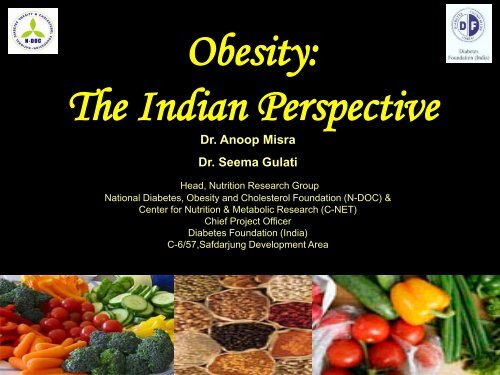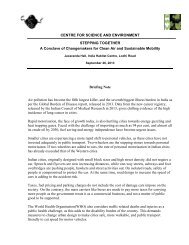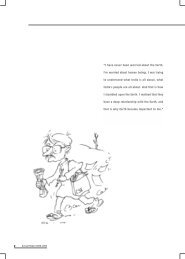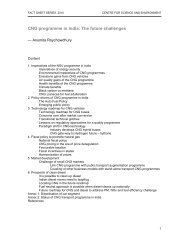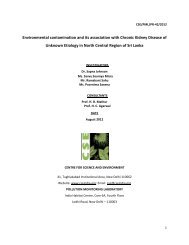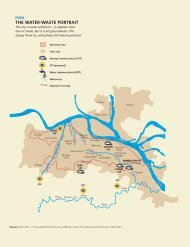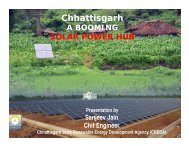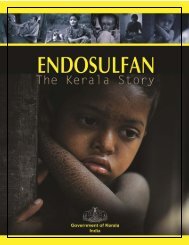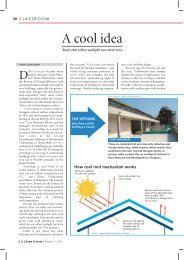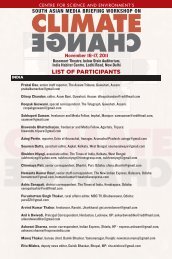Obesity: The Indian Perspective
Obesity: The Indian Perspective
Obesity: The Indian Perspective
Create successful ePaper yourself
Turn your PDF publications into a flip-book with our unique Google optimized e-Paper software.
<strong>Obesity</strong>:<br />
<strong>The</strong> <strong>Indian</strong> <strong>Perspective</strong><br />
Dr. Anoop Misra<br />
Dr. Seema Gulati<br />
Head, Nutrition Research Group<br />
National Diabetes, <strong>Obesity</strong> and Cholesterol Foundation (N-DOC) &<br />
Center for Nutrition & Metabolic Research (C-NET)<br />
Chief Project Officer<br />
Diabetes Foundation (India)<br />
C-6/57,Safdarjung Development Area
<strong>The</strong> Myth<br />
“You are talking of obesity,<br />
while malnutrition is<br />
everywhere”
Reality: <strong>The</strong> Double Jeopardy
Prevalence of overweight/obesity among Adolescents (14-18 yrs), Delhi<br />
Age<br />
(yrs) Gender<br />
14<br />
15<br />
16<br />
17<br />
Public Schools<br />
Overweight<br />
% (N=2593)<br />
Age wise<br />
prevalence in<br />
Public Schools<br />
Government<br />
Schools<br />
Overweight<br />
% (N= 955)<br />
Male 29.7<br />
12.9<br />
32.6<br />
Female 39.6 12.4<br />
Male 23.3<br />
11.8<br />
29.9<br />
Female 39.0 11.0<br />
Male 28.0<br />
7.8<br />
25.1<br />
Female 20.8 9.4<br />
Male 27.0<br />
9.4<br />
25.3<br />
Female 21.6 13.8<br />
Total%<br />
(N = 3548)<br />
29.0<br />
11.1<br />
OVERALL PREVALENCE = 24.2%<br />
Age wise<br />
prevalence in<br />
Government<br />
Schools<br />
12.7<br />
11.5<br />
8.4<br />
11.0<br />
Misra et al. Ann Nutr Metab.2011
Prevalence of Childhood<br />
Overweight/<strong>Obesity</strong><br />
Country/City Year Prevalence<br />
Global 2004 10<br />
USA/UK 2000 20<br />
Australia 1995 20<br />
India/Chennai 2002 22<br />
India/Delhi 2004 16<br />
India/Delhi 2006 29<br />
Misra et al., 2006
<strong>Obesity</strong> is Caused by Long-Term<br />
Positive Energy Balance<br />
Fat<br />
Stores<br />
↑ 2% = 2.3 kg in<br />
a year
Current Eating Habits<br />
• More than 40% of the children eat out once or more in a<br />
week<br />
• 70% children eat chips once or more in a week<br />
• 38% children eat burgers once or more in a week<br />
• 48% children eat pizzas once or more in a week<br />
• 40% eat french fries once or more in a week<br />
• 60% eat noodles and drink colas once or more in a<br />
week<br />
Misra et al., Unpublished data, 2008
<strong>The</strong> Myths<br />
2“Fat children are healthy. With<br />
age ‘baby fat’ will go away”<br />
Reality:<br />
50-70% of obese children will remain obese<br />
adults
<strong>Obesity</strong><br />
<strong>Obesity</strong> has reached<br />
alarming figures.<br />
Current figures in<br />
New<br />
Delhi indicate that<br />
every second person<br />
fulfills criteria of<br />
obesity or has<br />
excess<br />
abdominal fat.<br />
<strong>The</strong> Evidence
3<br />
<strong>The</strong> Myths<br />
“What will happen if a child is<br />
fat. He/she will not have any<br />
diseases”<br />
Reality:<br />
• Diabetes may strike early<br />
• Polycystic ovaries, excess facial hair and<br />
infertility may occur in girls
Once fat, you could<br />
develop diabetes<br />
and heart disease as<br />
early in twenties!!!!
Diabetes<br />
<strong>The</strong> Evidence<br />
<strong>The</strong> current load of diabetes<br />
in India is expected to<br />
increase by 170% in the next<br />
20 years. Our India-US<br />
collaborative study indicates<br />
that 1 in every 10 person in<br />
Delhi is a diabetic and 1 in<br />
every 5 <strong>Indian</strong> in US is a<br />
diabetic.
<strong>The</strong> Myths<br />
4 “Heart Disease starts<br />
at old age”<br />
Reality:<br />
Hardening and blockage of the arteries<br />
starts at 11 years in boys and 15 years<br />
in girls
Prevalence of Fibrous Plaques in Young<br />
Adults:<br />
<strong>The</strong> Bogalusa Heart Study<br />
Percent (%)<br />
120<br />
100<br />
80<br />
60<br />
arteries 40 starts at 11 years in boys<br />
20<br />
0<br />
Male<br />
Female<br />
Hardening and blockage of the<br />
and 15 years in girls<br />
2--10 11--15 16--20 21--25 26--30 31--39<br />
Age<br />
Berenson G, Am J Med Sci, 2001
<strong>The</strong> Evidence<br />
High Blood Pressure<br />
One in three urban<br />
<strong>Indian</strong>s have high<br />
blood pressure. It is<br />
predicted to increase<br />
by 60% in next 20 years.
5<br />
<strong>The</strong> Myths<br />
“A fat child is<br />
otherwise healthy”<br />
Reality:<br />
28% of urban children have syndrome X, one<br />
step away from diabetes and 2 steps away<br />
from heart disease
Syndrome X<br />
Nearly 35% of the<br />
general population<br />
and 1/4th of the<br />
adolescents have<br />
syndrome X, which<br />
predates diabetes<br />
and heart disease.<br />
<strong>The</strong> Evidence
% Prevalence<br />
80<br />
70<br />
60<br />
50<br />
40<br />
30<br />
20<br />
10<br />
Prevalence of Insulin Resistance (by HOMA-IR)<br />
Asian <strong>Indian</strong> Children (n=396)<br />
0<br />
Overall Prevalence; Males, 21.8%, Females, 35.8%<br />
20<br />
Males Females<br />
66.7<br />
21.3<br />
45<br />
16.7<br />
20.4<br />
58.2<br />
47.6<br />
Normal BMI High BMI Normal BF High BF<br />
Misra et al., Int J <strong>Obesity</strong>, 2004
50<br />
40<br />
30<br />
20<br />
10<br />
0<br />
Levels Correlate to <strong>Obesity</strong><br />
13<br />
% Prevalence hs-CRP in Asian <strong>Indian</strong> Children:<br />
24<br />
25<br />
All Overweight Obese<br />
Misra et al., Atherosclerosis, 2004
Diet and CRP:<br />
<strong>The</strong> Recommendation for Saturated Fat<br />
• Mean CRP:1.3 mg/L in children<br />
(moderate CV risk category)<br />
• 1% decrease in energy intake by<br />
saturated fat:CRP levels decrease by<br />
0.14mg/L<br />
• Saturated fat intake
6<br />
<strong>The</strong> Myths<br />
“A child does not<br />
develop high blood<br />
pressure or high<br />
cholesterol”<br />
Reality:<br />
Many children will have high blood pressure and<br />
low good cholesterol
Heart Disease<br />
<strong>The</strong> absolute death rate<br />
due to heart disease/<br />
shall increase in<br />
India from 1.6 million/y<br />
in the year 2000 to 2<br />
million in 2010 and<br />
2.6 million by the<br />
year 2020, an<br />
increase by 61%.<br />
<strong>The</strong> Evidence
7<br />
<strong>The</strong> Myths<br />
“A child should enjoy,<br />
and eat and relax. Such<br />
time will not come again<br />
later”<br />
Reality:<br />
Parents do not realize, but children are eating<br />
junk food all the time.
Consumption of lifestyle foods among<br />
Item Younger children Older Children<br />
> 2-3 times a week<br />
Chips/ Pringle 67.5 66.3<br />
Corn Puffs etc. 58.6 52.4<br />
Popcorn 32.8 28.2<br />
Soft Drinks 30.0 41.0<br />
Sherbets 42.3 45.6<br />
Ice-Creams 43.7 57.9<br />
Cakes/muffins 34.7 31.7<br />
Chocolates 71.3 74.7<br />
Fried Food 39.7 56.7<br />
Fast Food<br />
(Pizza/burger)<br />
Children<br />
22.0 30.93<br />
Misra et al. Unpublished data.2011
High Lipids<br />
1/3 rd <strong>Indian</strong>s have high<br />
levels of triglycerides (a<br />
form of bad cholesterol)<br />
and 30-70% have low levels<br />
of HDL (good cholesterol).<br />
<strong>The</strong> Evidence
8<br />
<strong>The</strong> Myths<br />
“All children are doing<br />
required physical<br />
activity”<br />
Reality:<br />
Time on TV, internet and studies leaves little<br />
time for play. Even in pd assigned for physical<br />
activity, many do not participate
Willingness to be physically more active<br />
Physical activity<br />
Younger<br />
Children<br />
9-11 years<br />
% (N=600)<br />
Older<br />
Children<br />
12-18 years<br />
%(N =1200)<br />
Willing 67.3 (404) 71.0 (852)<br />
Not Willing 32.7 (196) 28.6 (343)<br />
Do not know - 0.4 (5)<br />
Misra et al. Unpublished data.2011
Sedentary Activities among children<br />
Activity more than 60<br />
minutes<br />
TV viewing<br />
Book Reading<br />
Working on Computer<br />
Listening to Music<br />
Video Games<br />
Younger<br />
children<br />
%(N)<br />
70.3<br />
(407)<br />
55.0<br />
(269)<br />
55.6<br />
(163)<br />
30.6<br />
(129)<br />
53.7<br />
(122)<br />
Older<br />
children<br />
% (N)<br />
84.7<br />
(987)<br />
58.9<br />
(551)<br />
67.9<br />
(477)<br />
47.6<br />
(487)<br />
56.2<br />
(200)<br />
Misra et al. Unpublished data.2011
9 Reality:<br />
<strong>The</strong> Myths<br />
“All of us (parents,<br />
teachers) teach them<br />
correct diet and lifestyle”<br />
Most do not have correct knowledge or time to<br />
educate children. Healthy snacks are not<br />
prepared at home. Many parents and teachers<br />
are obese themselves! No cohesive intervention<br />
program in India
Consumption of lifestyle foods among<br />
Mothers<br />
Item Mothers of Younger<br />
Children<br />
> 2-3 times a week<br />
Mothers of Older<br />
Children<br />
Chips/ Pringle 53.3 56.7<br />
Corn Puffs etc. 31.0 47.2<br />
Popcorn 28.7 35.7<br />
Soft Drinks 24.7 27.8<br />
Sherbets 42.0 43.7<br />
Ice-Creams 43.4 48.2<br />
Cakes/muffins 23.7 29.16<br />
Chocolates 47.3 57.2<br />
Fried Food 38.8 37.7<br />
Fast Food 14.7 14.8<br />
Misra et al. Unpublished data.2011
Knowledge Regarding Unhealthy Diet and Diseases<br />
among Children<br />
Percentage<br />
90<br />
80<br />
70<br />
60<br />
50<br />
40<br />
30<br />
20<br />
10<br />
0<br />
Overweight<br />
Hypertension<br />
Younger Children Oldren Children<br />
High Triglycerides<br />
Cholesterol<br />
high Sugar<br />
Heart Disease<br />
Cancer<br />
Misra et al. Unpublished data.2011
Knowledge Regarding Unhealthy Diet and<br />
90<br />
80<br />
70<br />
60<br />
50<br />
40<br />
30<br />
20<br />
10<br />
0<br />
Overweight and <strong>Obesity</strong><br />
Diseases among Mothers<br />
Hypertension<br />
High Triglycerides<br />
Yes No<br />
Hight Cholesterol<br />
High sugar<br />
Heart Disease<br />
cancer<br />
Misra et al. Unpublished data.2011
Relationship Between Food Consumption Pattern<br />
of Mother and Children<br />
Correlation analysis was done for food consumption of<br />
mothers and children. A very high order correlation was<br />
found for the following food items:<br />
-cereals<br />
-pulses<br />
-vegetables<br />
-Milk and Milk products<br />
-Meat and Poultry<br />
-Fruits and fruit juices<br />
-Nuts<br />
Misra et al. Unpublished data.2011
10<br />
<strong>The</strong> Myths<br />
“So what if there are<br />
metabolic abnormalities<br />
or diseases, these can<br />
be easily treated”<br />
Reality:<br />
Most of these diseases are catastrophic<br />
and have complications that cannot be<br />
reversed. Most will shorten lifespan
Pulmonary disease<br />
abnormal function<br />
obstructive sleep apnea<br />
hypoventilation syndrome syndrome<br />
Nonalcoholic fatty liver<br />
disease<br />
steatosis<br />
steatohepatitis<br />
cirrhosis<br />
Gall bladder disease<br />
Complications of <strong>Obesity</strong><br />
Gynecologic abnormalities<br />
abnormal menses<br />
infertility<br />
polycystic ovarian syndrome<br />
Osteoarthritis<br />
Skin<br />
Gout<br />
Idiopathic intracranial<br />
hypertension<br />
Stroke<br />
Cataract<br />
Coronary heart disease<br />
Diabetes<br />
Dyslipidemia<br />
Hypertension<br />
Severe pancreatitis<br />
Cancer<br />
breast, uterus, cervix<br />
colon, esophagus, pancreas<br />
kidney, prostate<br />
Phlebitis Phlebitis<br />
venous venous stasis stasis
Hypertension<br />
Depression<br />
Heart Diseases<br />
Osteoarthritis<br />
Optical<br />
disorders<br />
Diabetes<br />
<strong>Obesity</strong><br />
and<br />
Health<br />
risks<br />
Stroke<br />
Respiratory<br />
Problems<br />
Renal Disease<br />
Gall Bladder<br />
disease<br />
Cancer<br />
Infertility
Causes And Prevention
Unhealthy Eating Habits<br />
Erratic eating habits<br />
Frequent fast and fried food consumption<br />
Excess intake of colas<br />
Excess consumption of refined foods<br />
Not consuming enough fruits and vegetables
Sedentary Lifestyle<br />
Lack of Physical Activity :<br />
67% children spend less than 1 hour in<br />
physical activity
Macronutrients Gender<br />
Energy<br />
(kcal/day)<br />
Protein<br />
(g/day)<br />
Carbohydrate<br />
(g/day)<br />
Total fat<br />
(g/day)<br />
Macronutrient Intake Profile of the<br />
Asian <strong>Indian</strong> Adolescents (Urban)<br />
RDA*<br />
%energy<br />
13-15y<br />
(n=254)<br />
16-18y<br />
(n=543) p-value<br />
unit/d % energy unit/d % energy<br />
Boys<br />
2339±498 − 2324 ± 549 − 0.856<br />
−<br />
Girls 1905 ± 472 − 1820 ± 421 − 0.045<br />
Boys<br />
69 ± 19 12 ± 2 68 ± 18 12 ± 1 0.900<br />
10-15%<br />
Girls 53 ± 16 11 ± 1 50 ± 13 11 ± 2 0.001<br />
Boys<br />
316 ± 71 54 ± 7 313 ± 77 54 ± 8 0.352<br />
55-65%<br />
Girls 238 ± 53 51 ± 7 239 ± 62 53 ± 6 0.892<br />
Boys<br />
85 ± 26 32 ± 6 84 ± 30 32 ± 7 0.681<br />
15-30%<br />
Girls 77 ± 25 36 ± 6 71 ± 21 35 ± 6 0.030<br />
* Recommended Dietary Allowance (Figures mentioned are Mean ± SD)<br />
Misra et al., JACN 2009
Health and Nutrition Education Initiatives<br />
by Diabetes Foundation (India)
Diabetes Foundation (India) has pioneered in<br />
launching Health and Nutrition Education<br />
initiatives, the first of their kinds in the whole of<br />
South Asia to spread the awareness of <strong>Obesity</strong> and<br />
Diabetes prevention amongst the youth
Diabetes and <strong>Obesity</strong> Awareness for Children/Adolescents &<br />
Adults<br />
A 50 city country wide awareness and education program<br />
Initiative of National Diabetes, <strong>Obesity</strong>, and Cholesterol Diseases Foundation<br />
March 5, 2011
Objectives<br />
Overall Aim:<br />
To create mass awareness about diabetes<br />
and obesity among children and adults<br />
and to thus act as change agents for better<br />
lifestyles and prevention of diabetes<br />
Initiative of National Diabetes, <strong>Obesity</strong>, and Cholesterol Diseases Foundation<br />
& Emcure Pharmaceutical (India) Pvt. Ltd<br />
March 5, 2011
Specific Objectives<br />
Objectives<br />
• To enhance awareness among school children, and<br />
adults about diabetes and obesity through<br />
– Lectures on “Diabetes: Causes, Consequences, Prevention<br />
& Care”<br />
– School Health Camps<br />
– Public Awareness Campaign:<br />
• Public Health Lectures on “Diabetes: Causes, Consequences,<br />
Prevention and Care”<br />
• Diabetes Health Camps<br />
• Walk for Awareness about Diabetes Prevention on November<br />
14, 2011 – World Diabetes Day<br />
• Distribution of printed education material to children and<br />
adults<br />
• Message dissemination through media<br />
Initiative of National Diabetes, <strong>Obesity</strong>, and Cholesterol Diseases Foundation<br />
& Emcure Pharmaceutical (India) Pvt. Ltd<br />
March 5, 2011
Participating Teams<br />
Across<br />
50 cities<br />
in India<br />
Initiative of National Diabetes, <strong>Obesity</strong>, and Cholesterol Diseases Foundation<br />
& Emcure Pharmaceutical (India) Pvt. Ltd<br />
March 5, 2011
Initiatives being implemented in<br />
various cities of India<br />
New Delhi Dehradun<br />
Mumbai Allahabad<br />
Jaipur Bangalore<br />
Agra Pantnagar<br />
Chandigarh Pune<br />
Vadodara Lucknow<br />
Noida Bhubaneshwar
“MARG” (<strong>The</strong> Path)<br />
Medical education for children/<br />
Adolescents for Realistic prevention of<br />
obesity and diabetes and for healthy aGing<br />
A Project of<br />
Diabetes Foundation (India)<br />
Funded by: World Diabetes Foundation<br />
(Denmark)
<strong>The</strong> initiatives are organizing activities to focus on:<br />
1. changing the individual<br />
(children, family, teachers)<br />
2. changing the environment<br />
(school, home)
Information and Educational Material for<br />
Children, Parents and Teachers
“TEACHER””<br />
Trends in Childhood Nutrition and<br />
Lifestyle Factors in India<br />
A 6 City Countrywide Project of<br />
Diabetes Foundation (India)
“CHETNA”<br />
Children’s Health Education Through<br />
Nutrition and Health Awareness Program<br />
A Project of<br />
Diabetes Foundation (India)<br />
Funded by: Rotary Club South East (Delhi)
Children attending the lectures on<br />
Healthy Living
Teachers participating in a lecture<br />
on Healthy Living
Mothers participating in a Focused Group Discussion
Poster Making Competition
Poster Making Competition
Cooking Competition
Skit Competition
Extempore Competition
Quiz Competition
• Card Making<br />
• Collage Making<br />
• Health Board setup<br />
• Mask Making<br />
• Cartoon strip making<br />
• Poem writing<br />
• Healthy recipe writing<br />
• Healthy Tiffin Day<br />
Other Activities
Study<br />
School-based Intervention Trial for Prevention of<br />
Childhood <strong>Obesity</strong>: <strong>The</strong> MARG Study<br />
Objective:<br />
To study the effect of an educative and participatory<br />
intervention trial for a period of 6 months on the<br />
improvement of knowledge levels, anthropometric<br />
measurements, body composition and blood profile of<br />
urban adolescents aged 15-17 years.<br />
A Case-Control Community Intervention Trial<br />
101 cases and 108 controls<br />
6 months: July, 2008-January, 2009<br />
Misra et al., Eur J Clin Nutr 2010
Key Activities:<br />
Intervention Trial (6 months):<br />
Case Control Design<br />
1. Intensive intervention vs. usual intervention<br />
2. Improvements in the following aspects:<br />
a. Knowledge levels<br />
b. Dietary habits<br />
c. Anthropometric measurements<br />
d. Body fat composition<br />
e. Glycemic indicators<br />
f. Insulin levels, CRP levels<br />
g. Lipid profile
Phase 2:<br />
Interventions<br />
Weekly individual counseling of children<br />
Lectures<br />
Activities: Skits, quiz competition, extempore, focused group<br />
discussions<br />
Replacing unhealthy food in canteen with healthy alternatives<br />
Health camp for parents and teachers<br />
Recipe demonstration for healthy Tiffin<br />
Skit demonstration by the intervention group in morning<br />
assembly on important days like the World Food Day<br />
Quiz competition in class<br />
Paragraph writing on topics like: Ways in which you can<br />
prevent yourself from diabetes and heart disease in the next 5-8<br />
years, healthy alternatives to junk food, planning a day’s diet for<br />
themselves, planning their own tiffins for a week<br />
Checking tiffins of younger classes in their school by the<br />
intervention group
% Decrease in Consumption Patterns of ‘Energy-Dense Foods”<br />
Consumption of Food Articles Case School Control School<br />
Sweetened carbonated drinks > 3 times/w 15.4% 7.9%<br />
Western ‘energy-dense’ foods (Burgers,<br />
pizzas, french fries, noodles) > 3 times/w<br />
9.2% 1.4%<br />
Chips/ Namkeen/Maggi > 3 times/w 8.3% No change<br />
<strong>Indian</strong> ‘energy-dense’ food > 3 times/w 6.3% 2.2%<br />
All differences are statistically significant<br />
Singhal N, Misra A, Shah P, Gulati S. Eur J Clin Nutr, in press
Consumption of Fruits (brought in Tiffin)<br />
Case School Control School<br />
Baseline 10.1% 29.8%<br />
Follow-up 40.4%* 25.9%<br />
*Statistically significant<br />
Singhal N, Misra A, Shah P, Gulati S. Eur J Clin Nutr, in press
% Change in Time Spent in TV Viewing<br />
and Physical Activity<br />
Variables Case<br />
School<br />
Control<br />
School<br />
TV Viewing > 2 h/d 5.2% 2.4%<br />
Physical Activity<br />
30-60 min/d<br />
All differences are statistically significant<br />
9.8 % 3.7%<br />
Singhal N, Misra A, Shah P, Gulati S. Eur J Clin Nutr, in press
Knowledge, Attitude and Practice about<br />
Nutrition, <strong>Obesity</strong> and Diabetes:<br />
Pre- and Post Surveys Show significant Increase in Knowledge<br />
80<br />
70<br />
60<br />
50<br />
40<br />
30<br />
20<br />
10<br />
0<br />
Healthy<br />
living<br />
Junk<br />
food<br />
<strong>Obesity</strong> Diet and<br />
DM<br />
Pre<br />
Post<br />
Shah P, Misra A et al., Br J Nutr 2010
4%<br />
2%<br />
0%<br />
-2%<br />
-4%<br />
-6%<br />
-8%<br />
-10%<br />
-12%<br />
-14%<br />
% Change in Anthropometric Parameters<br />
WC Mid -thigh SAD Triceps Biceps<br />
Case Control<br />
P< 0.05 in Control SAD<br />
P< 0.001 in Case biceps<br />
Singhal N, Misra A, Shah P, Gulati S. Eur J Clin Nutr, in press
Variable Case School Control School<br />
Fasting Glucose -4.9%* -2.2%<br />
*p < 0.001<br />
% Change in Metabolic Parameters<br />
HDL-C 2.2% -2.3%<br />
Singhal N, Misra A, Shah P, Gulati S. Eur J Clin Nutr, in press
% Change in Fasting Serum Insulin and CRP<br />
6.2<br />
13<br />
INT. CONT.<br />
Insulin Hs-CRP<br />
-21.6<br />
Misra et al., Unpublished data<br />
47<br />
CONT.
Summary<br />
• Rising childhood obesity in urban India and in<br />
other Developing Countries is of great concern,<br />
and would fuel the diabetes and the metabolic<br />
syndrome epidemics further.<br />
• Overall, it is more in urban areas (vs. rural), and<br />
public schools.<br />
• Its consequences, insulin resistance, PCOS,<br />
hirsutism, type 2 diabetes, subclinical<br />
inflammation and hepatic steatosis are now<br />
frequently seen in children .<br />
• Countrywide programs, akin to our program<br />
“MARG” in schoolchildren are urgently needed.
Thank You<br />
Thank You…<br />
seemagulati2007@gmail.com


